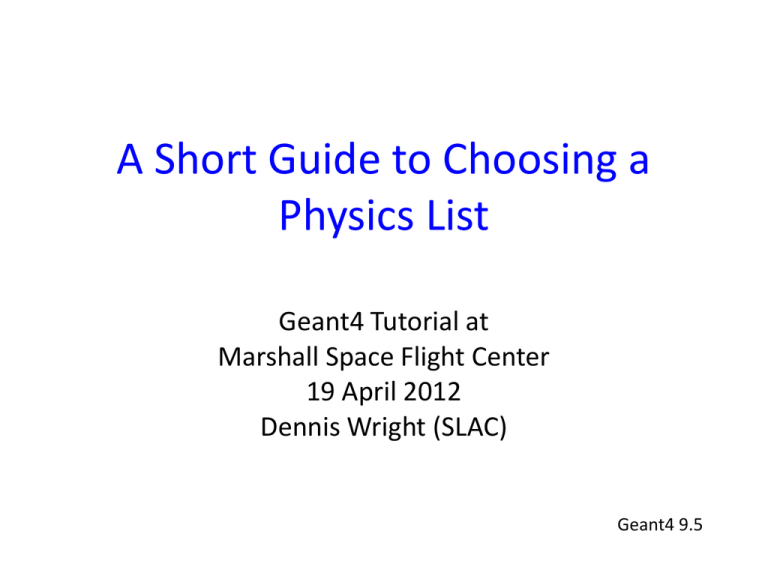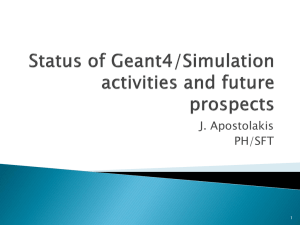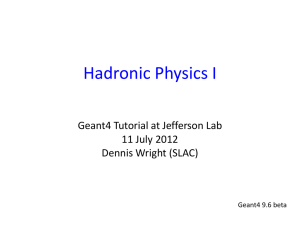PPT - Geant4
advertisement

A Short Guide to Choosing a Physics List Geant4 Tutorial at Marshall Space Flight Center 19 April 2012 Dennis Wright (SLAC) Geant4 9.5 Introduction • Which physics list you use is highly dependent on your use case • Before choosing, or building your own, familiarize yourself with the major physics processes available • the process-model catalog is useful for this • see Geant4 web page under User Support, item 10b • Geant4 provides several “reference physics lists” which are routinely validated and updated with each release • these should be considered only as starting points which you may need to validate or modify for your application • There are also many physics lists in the examples which you can copy • these are usually very specific to a given use case 2 Introduction • There are currently 28 “pre-packaged” physics lists available • but you will likely be interested in only a few, namely the “reference” physics lists • many physics lists are either developmental or customized in some way, and so not very useful to new users • All but one of the pre-packaged physics lists use templates • the LBE physics list is the old-style “flat” list without templates or physics builders • it is soon to be replaced with a more up-to-date flat list • Reference physics lists: • FTFP_BERT, QGSP_BERT, FTFP_BERT_HP, QGSP_BIC, Shielding • plus a few more 3 Physics List Naming Convention • The following acronyms refer to various hadronic options • QGS -> Quark Gluon String model (>~20 GeV) • FTF -> Fritiof string model (>~5 GeV) • LHEP -> Low and High energy parameterized model (being phased out) • BIC -> Binary Cascade (<~ 10 GeV) • BERT -> Bertini-style cascade (<~ 10 GeV) • HP -> High Precision neutron model ( < 20 MeV) • P -> G4Precompund model used for de-excitation • EM options designated by • no suffix : standard EM physics • EMV suffix : older but faster EM processes 4 Reference Physics Lists • FTFP_BERT – – – – – recommended by Geant4 for HEP ATLAS plans to switch to this from QGSP_BERT contains all standard EM processes uses Bertini-style cascade for hadrons < 5 GeV uses FTF (Fritiof) model for high energies ( > 4 GeV) • QGSP_BERT – – – – all standard EM processes Bertini-style cascade up to 9.5 GeV QGS model for high energies (> 20 GeV) LEP (Low Energy Parameterized models) in between 5 Reference Physics Lists • QGSP_BERT_EMV – also recommended by Geant4 for HEP – currently used by CMS – same as QGSP_BERT, but with EM processes tuned for better CPU performance – increase in speed comes with a slight decrease in EM precision • FTFP_BERT_HP – same as FTFP_BERT, but with high precision neutron model used for neutrons below 20 MeV – significantly slower the FTFP_BERT when full thermal cross sections used – there’s an option to turn this off – for radiation protection and shielding applications 6 Reference Physics Lists • QGSP_BIC – same as QGSP_BERT but replaces Bertini cascade with Binary cascade and G4Precompound model – recommended for use at energies below 200 MeV (many medical applications) • QGSP_BIC_HP – same as QGSP_BIC, but with high precision neutron model used for neutrons below 20 MeV – recommended for radiation protection, shielding and medical applications 7 Reference Physics Lists • Shielding – based on FTFP_BERT_HP with improved neutron cross sections from JENDL – better ion interactions using QMD model – currently used by SuperCDMS dark matter search – recommended for: – shielding applications – space physics – HEP 8 Other Physics Lists (based on use case) • If primary particle energy in your application is < 5 GeV (for example, clinical proton beam of 150 MeV) – start with a physics list which includes BIC or BERT – e.g. QGSP_BIC, QGSP_BERT, FTFP_BERT, etc. • If neutron transport is important – start with physics list containing “HP” – e.g. QGSP_BIC_HP, FTFP_BERT_HP, etc. • If you’re interested in Bragg curve physics – use a physics list ending in “EMV” or “EMX” – e.g. QGSP_BERT_EMV 9 Other Physics Lists (based on use case) • For ion-ion physics lists see Tatsumi Koi (SLAC) – a custom-designed physics list – usually employs QMD model • For optical photon transport – start with the LBE physics list – list is a bit old, but optical code can be extracted for other applications • For radioactive decay – use LBE list as an example • For detailed line emissions from EM processes – LBE or see following slide 10 Alternate EM Physics Lists • Up to now, most physics lists mentioned have used the “standard” EM processes, but “low energy” EM physics is also available • • • • G4EmLivermorePhysics (physics list suffix = LIV) G4EmLivermorePolarizedPhysics G4EmPenelopePhysics (suffix = PEN) G4EmDNAPhysics • Physics lists containing these are recommended for microdosimetry applications • For examples using a DNA physics list, go to • geant4/source/examples/advanced 11 Using Alternate EM Physics Lists • These physics list classes derive from the G4VPhysicsConstructor abstract base class • A good implementation example that uses these already available physics lists can be found in • examples/extended/electromagnetic/TestEm2 • Once you know the desired hadronic part of the physics list name (e.g. FTFP_BERT) an easy way to keep straight the various EM options is to use the G4PhysListFactory class: • G4PhysListFactory factory; G4VModularPhysicsList* physList = factory.GetReferencePhysList(“FTFP_BERT_ XXX”); // where XXX = EMV or EMX or LIV or PEN 12 Using Geant4 Validation to Choose Physics Lists • Ultimately you must choose a physics list based on how well its component processes and models perform • physics performance • CPU performance • Geant4 provides validation (comparison to data) for most of its physics codes • validation is a continuing task, performed at least as often as each release • more validation tests added as time goes on • To access these comparisons, go to Geant4 website – click on the “Results and Publications” , then – “Validation and testing”, then “Hadronic Validation Web Pages” – then “New Validation Framework” 13 New Hadronic Validation Framework 14 IAEA Validation Tests (Hadronic) 15 Specific Hadronic Validation Test 16 Documentation of Physics Lists • When you run one of the reference physics lists, the log output will contain • a list of processes and models included • the energies over which they are applied • similar information about cross section data sets will be included soon • Geant4 web page will soon include html output of the above information 17








